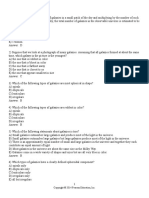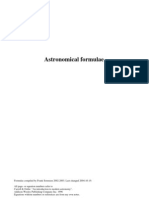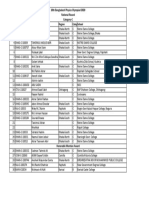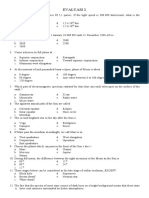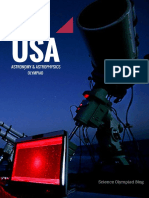St. Joseph Astronomy Olympiad 2015 (Junior)
St. Joseph Astronomy Olympiad 2015 (Junior)
Uploaded by
Science Olympiad BlogCopyright:
Available Formats
St. Joseph Astronomy Olympiad 2015 (Junior)
St. Joseph Astronomy Olympiad 2015 (Junior)
Uploaded by
Science Olympiad BlogOriginal Description:
Copyright
Available Formats
Share this document
Did you find this document useful?
Is this content inappropriate?
Copyright:
Available Formats
St. Joseph Astronomy Olympiad 2015 (Junior)
St. Joseph Astronomy Olympiad 2015 (Junior)
Uploaded by
Science Olympiad BlogCopyright:
Available Formats
ANNUAL SCIENCE FESTIVAL 2015
ST. JOSEPH HIGHER SECONDARY SCHOOL
ASTRONOMY OLYMPIAD
(Class 9-10)
Total Mark: 50 (MCQ 40, Math 10)
1. Which planets rotate on its axis from east
to west?
a. Jupiter & Venus
b. Venus & Mercury
c. Uranus & Neptune
d. Venus & Uranus
2. The minimum distance between the sun
and the earth occurs on a. December 22
b. June 21
c. January 3
d. September 22
3. When the sun is nearest to the earth, the
earth is said to be in a. Aphelion
b. Perihelion
c. Apogee
d. Perigee
4. How much of the surface of the moon is
visible from the earth a. About 59%
b. More than 75%
c. Only about 40%
d. Only about 25%
5. On the surface of the moon the a. Mass and weight become less
b. Only the mass is less
c. Mass remain constant and only the
weight is less
d. Mass and weight both remain
unchanged
Time: 30 Minutes
6. When a superior planet is at opposition
it is making an angle of how many
degrees with the sun?
a. 0 degrees
b. 45 degrees
c. 90 degrees
d. 180 degrees
7. A Galactic year is the length of time that
it takes our sun to orbit the galaxy. In
Earth years, how long is a Galactic year?
a. 100 million years
b. 230 million years
c. 620 million years
d. 940 million years
8. The habitable zone around a star is _____?
a. The region around a star where liquid
water can exist on planetary surfaces
b. The region around a star where life
exists
c. The region around a star where humans
can survive
d. The region around a star where rocky
planets form
e. The region around a star where the
ultraviolet radiation does not destroy
organisms on a planetary surface
9. How are galaxies important to our
existence?
a. Without galaxies, the universe could not
be expanding
b. Without galaxies, there could not have
been a Big Bang
c. Galaxies Prevent planets from leaving
their orbits around stars; e.g. our galaxy
prevents the earth from leaving its
orbits of the Sun
d. Galaxies recycle heavy elements
produced in stars into future
generations of stars
ANNUAL SCIENCE FESTIVAL 2015
ST. JOSEPH HIGHER SECONDARY SCHOOL
10. Who discovered that Jupiter has moons?
a. Aristotle
b. Ptolemy
c. Kepler
d. Galileo
e. Tycho Brahe
11. From laboratory measurements, we
know that a particular spectral line
formed by hydrogen appears at a
wavelength of 486.1 nanometers (nm).
The spectrum of a particular star has the
same hydrogen line appearing at a
wavelength of 485.9nm. What can we
conclude?
a. The star is getting hotter.
b. The star is getting colder.
c. The "star" actually is a planet.
d. The star is moving toward us.
e. The star is moving away from us.
12. Which planet has the highest average
surface temperature and why?
a. Mercury, because it is closest to the Sun
b. Mercury, because of its dense carbon
dioxide atmosphere
c. Venus, because of its dense carbon
dioxide atmosphere
d. Mars, because of its red color
e. Jupiter, because it is so big
13. Which two properties are most
important in determining the surface
temperature of a planet?
a. Size and distance from the Sun
b. Internal temperature and atmosphere
c. Size and chemical composition
d. Distance from the sun and atmosphere
e. Size and atmosphere
14. Which of the following statements about
the sunspot cycle is not true?
a. The number of sunspots peaks
approximately every 11 years.
b. With each subsequent peak in the
number of sunspots, the magnetic
polarity of the Sun is the reverse of the
previous peak.
c. The rate of nuclear fusion in the Sun
peaks about every 11 years.
d.
e.
The cycle is truly a cycle of magnetic
activity, and variations in the number of
sunspots are only one manifestation of
the cycle.
The number of solar flares peaks about
every 11 years.
15. On a Hertzsprung-Russell diagram,
where on the main sequence would we
find stars that have the greatest mass?
a. Lower right
b. Upper right
c. Upper left
d. Lower left
e. None of the above
16. Sirius is a spectral type A star whereas
Rigel is a spectral type B star. What can
we conclude?
a. Sirius has a higher core temperature
than Rigel.
b. Rigel has a higher surface temperature
than Sirius.
c. Sirius has a higher surface temperature
than Rigel.
d. Rigel has a higher core temperature
than Sirius.
e. Sirius and Rigel have the same
temperature
17. Space within clusters of galaxies is not
expanding because ____________?
1. Expansion of the universe affects only
empty space, not space in which matter
is present.
2. The universe is not old enough yet for
these objects to have begun their
expansion.
3. Space IS expanding within clusters of
galaxies, which is why clusters tend to
grow in size with time.
4. Their gravity is strong enough to hold
them together even while the universe
as a whole expands.
5. There is not enough matter in the
clusters to repel the galaxies away
ANNUAL SCIENCE FESTIVAL 2015
ST. JOSEPH HIGHER SECONDARY SCHOOL
18. What does the Schwarzschild radius of a
black hole depend on?
a. Whether the black hole formed in a
massive-star supernova or in some
other way
b. The radius of the black hole, as
measured by careful observations of its
size
c. Both the mass and the chemical
composition of the black hole
d. Only the mass of the black hole
e. The colour of the black hole
19. Which of the following places is not
generally considered a potential home
for life in our solar system?
a. Jupiter's atmosphere
b. Europa
c. Mars
d. Ganymede
e. All of the above
ANSWER
II. Sirius is an A1V main sequence star. Use the
H-R diagram (given below) to find the
luminosity and surface temperature of Sirius.
(Show Reasoning)
20. We do not expect to find life on planets
orbiting high-mass stars because?
a. Planets cannot have stable orbits
around high-mass stars.
b. The stars are too hot to allow for life.
c. The lifetime of a high-mass star is too
short.
d. The high-mass stars emit too much
ultraviolet radiation.
e. They emit too much ultraviolet
radiation
ANSWER
Short Question
(52=10)
I. By how many times is the light of the Moon
at full moon weaker than that of the Sun if the
stellar magnitude of the moon is -12.5 and that
of the Sun -26.7?
Clue: Magnitude is the logarithmic measure of
the brightness of an object. Every interval of one
magnitude equates to a variation in brightness
of 1001/5 or roughly 2.512 times.
You might also like
- IBO Papers (1990-2013)Document3,277 pagesIBO Papers (1990-2013)Science Olympiad Blog90% (10)
- Australian Mathematical Olympiads 1996 2011 Book 2Document233 pagesAustralian Mathematical Olympiads 1996 2011 Book 2cronwellq83% (18)
- USAPhO Problems (2007-2014)Document311 pagesUSAPhO Problems (2007-2014)Science Olympiad Blog95% (19)
- Singapore Physics Olympiad 2010Document8 pagesSingapore Physics Olympiad 2010Science Olympiad Blog75% (8)
- Astronomy - Chapter 18 TestDocument36 pagesAstronomy - Chapter 18 TestJ. R. Silvey100% (3)
- Test Bank For Discovering The Universe 10th Edition by CominsDocument42 pagesTest Bank For Discovering The Universe 10th Edition by Cominsa558645663No ratings yet
- Fermat'S Principle: Optics RayDocument4 pagesFermat'S Principle: Optics RayBavani SagathevanNo ratings yet
- Astronomy - Chapter 11 TestDocument40 pagesAstronomy - Chapter 11 TestJ. R. Silvey100% (3)
- Astronomy - Chapter 14 TestDocument28 pagesAstronomy - Chapter 14 TestJ. R. SilveyNo ratings yet
- Physical Processes in Circumstellar Disks around Young StarsFrom EverandPhysical Processes in Circumstellar Disks around Young StarsPaulo J. V. GarciaNo ratings yet
- Indian National Astronomy Olympiad 2016Document16 pagesIndian National Astronomy Olympiad 2016Science Olympiad Blog100% (7)
- IPhO Problems (1967-1995)Document536 pagesIPhO Problems (1967-1995)Science Olympiad Blog100% (2)
- IPhO 2015 ProblemsDocument21 pagesIPhO 2015 ProblemsScience Olympiad BlogNo ratings yet
- IOAA Question Paper 2013Document75 pagesIOAA Question Paper 2013Science Olympiad Blog100% (10)
- IOAA 2010, China (Problems & Solutions)Document52 pagesIOAA 2010, China (Problems & Solutions)Science Olympiad Blog78% (9)
- IOAA 2007, Thailand (Problems)Document18 pagesIOAA 2007, Thailand (Problems)Science Olympiad Blog75% (4)
- Practice Test SpaceDocument8 pagesPractice Test Spaceapi-291011460100% (1)
- NAT - Assignment Chapters 12 13 14Document5 pagesNAT - Assignment Chapters 12 13 14Charity HubbardNo ratings yet
- Chapter 1 TestDocument57 pagesChapter 1 TestRubab Ali80% (5)
- Solar System KEY PDFDocument32 pagesSolar System KEY PDFAchmad FahrizaNo ratings yet
- Bangladesh Astronomy Olympiad, 2013 (National Round)Document6 pagesBangladesh Astronomy Olympiad, 2013 (National Round)Science Olympiad Blog83% (6)
- Astronomy Assessment Solar System-Sun Moon EarthDocument3 pagesAstronomy Assessment Solar System-Sun Moon Earthapi-132786865No ratings yet
- Bangladesh Astronomy Olympiad 2010 (National)Document1 pageBangladesh Astronomy Olympiad 2010 (National)Science Olympiad Blog100% (4)
- Chapter 11 Jovian Planet Systems: The Cosmic Perspective, 7e (Bennett Et Al.)Document20 pagesChapter 11 Jovian Planet Systems: The Cosmic Perspective, 7e (Bennett Et Al.)Edwin ChuenNo ratings yet
- Astronomy NotesDocument12 pagesAstronomy NotesYQ WheatonNo ratings yet
- Galaxy Analysis and Identification Lab ProcedureDocument3 pagesGalaxy Analysis and Identification Lab ProcedurejoeNo ratings yet
- Simple Cosmological Models: Detail AnalysisDocument28 pagesSimple Cosmological Models: Detail AnalysisShearyar KhanNo ratings yet
- Greenhouse Effect Atmosphere Carbon Dioxide Nitrous Oxide MethaneDocument11 pagesGreenhouse Effect Atmosphere Carbon Dioxide Nitrous Oxide MethaneCham BañesNo ratings yet
- Chapter 14 Our Star: The Cosmic Perspective, 7e (Bennett Et Al.)Document22 pagesChapter 14 Our Star: The Cosmic Perspective, 7e (Bennett Et Al.)Edwin ChuenNo ratings yet
- Exam 4Document55 pagesExam 4danNo ratings yet
- Newton's Universal Law of GravitationDocument18 pagesNewton's Universal Law of GravitationSyEd Mohammed IfrahimNo ratings yet
- Chapter 10 Planetary Atmospheres: Earth and The Other Terrestrial WorldsDocument27 pagesChapter 10 Planetary Atmospheres: Earth and The Other Terrestrial WorldsEdwin ChuenNo ratings yet
- IAO Final Papers - Problem Sets: Theory TestsDocument10 pagesIAO Final Papers - Problem Sets: Theory TestsOmidreza NazariNo ratings yet
- Galaxy Evolution StoryDocument7 pagesGalaxy Evolution StoryParag MahajaniNo ratings yet
- Chapter 16 Star Birth: The Cosmic Perspective, 7e (Bennett Et Al.)Document19 pagesChapter 16 Star Birth: The Cosmic Perspective, 7e (Bennett Et Al.)Edwin ChuenNo ratings yet
- ws1 2008Document12 pagesws1 2008gebikimameNo ratings yet
- IOAA SyllabusDocument5 pagesIOAA SyllabusScience Olympiad Blog100% (5)
- Celestial Mechanics & Binary SystemsDocument34 pagesCelestial Mechanics & Binary SystemsYang Woo SeongNo ratings yet
- Chapter 22 The Birth of The Universe: The Cosmic Perspective, 7e (Bennett Et Al.)Document20 pagesChapter 22 The Birth of The Universe: The Cosmic Perspective, 7e (Bennett Et Al.)mark100% (1)
- Surveying The Stars: Insert TCP 5e Chapter 15 OpenerDocument89 pagesSurveying The Stars: Insert TCP 5e Chapter 15 Openerlittleitaly5No ratings yet
- Bangladesh Astronomy Olympiad 2015 (Divisional)Document8 pagesBangladesh Astronomy Olympiad 2015 (Divisional)Science Olympiad Blog88% (17)
- Work Sheet - III For Nasa Scrutiny ExaminationDocument3 pagesWork Sheet - III For Nasa Scrutiny ExaminationAzfar Azfar100% (1)
- Astronomy FormulaeDocument36 pagesAstronomy Formulaeescherer1099100% (4)
- Physics Outreach Program Physics Olympiad Preparation 2012-2013Document2 pagesPhysics Outreach Program Physics Olympiad Preparation 2012-2013anand22233No ratings yet
- The Cosmic Perspective, 7th International Edition 20 - TestbankDocument18 pagesThe Cosmic Perspective, 7th International Edition 20 - TestbankEdward YangNo ratings yet
- Chapter 19 Our Galaxy: The Cosmic Perspective, 7e (Bennett Et Al.)Document20 pagesChapter 19 Our Galaxy: The Cosmic Perspective, 7e (Bennett Et Al.)Edwin ChuenNo ratings yet
- Stellar EvolutionDocument5 pagesStellar EvolutionMayar AzzamNo ratings yet
- Compare The Size of The Earth With Other PlanetsDocument16 pagesCompare The Size of The Earth With Other PlanetsArif ShiekhNo ratings yet
- Second Law of ThermodynamicsDocument18 pagesSecond Law of ThermodynamicsChristopher MorrisNo ratings yet
- ASTRONOMI CompressedDocument15 pagesASTRONOMI Compressedliaajahh22No ratings yet
- Astro MCQ Answers Multiple Choice QuestionsDocument138 pagesAstro MCQ Answers Multiple Choice QuestionsKRITANTNo ratings yet
- Stars As Laboratories For Fundamental PhysicsDocument684 pagesStars As Laboratories For Fundamental PhysicsalivNo ratings yet
- Astr101 - MCQ BankDocument16 pagesAstr101 - MCQ BankahmadnooraldeenNo ratings yet
- Universe: Structure and Evolution of The Universe WorkshopDocument35 pagesUniverse: Structure and Evolution of The Universe WorkshopPrashantJoshi100% (1)
- Category C 2020 BDPHO ResultDocument1 pageCategory C 2020 BDPHO ResultAhmed Saad Sabit0% (1)
- Bangladesh Astronomy Olympiad 2012Document5 pagesBangladesh Astronomy Olympiad 2012Science Olympiad Blog82% (17)
- The Solar System Questions KEYDocument64 pagesThe Solar System Questions KEYTel AntonNo ratings yet
- Dark Matter, Dark Energy, and The Fate of The UniverseDocument25 pagesDark Matter, Dark Energy, and The Fate of The UniverseKESH MusicNo ratings yet
- English: XVII Международная астрономическая олимпиада XVII International Astronomy OlympiadDocument27 pagesEnglish: XVII Международная астрономическая олимпиада XVII International Astronomy OlympiadOmidreza NazariNo ratings yet
- The Second Law of Thermodynamics: Fundamentals of Thermal-Fluid SciencesDocument42 pagesThe Second Law of Thermodynamics: Fundamentals of Thermal-Fluid SciencesMahrukh ChaudharyNo ratings yet
- The Cosmic Perspective, 7e (Bennett Et Al.) Chapter 1 A Modern View of The UniverseDocument19 pagesThe Cosmic Perspective, 7e (Bennett Et Al.) Chapter 1 A Modern View of The UniverseD.J Cassidy100% (1)
- Work, Power Energy Q&ADocument93 pagesWork, Power Energy Q&ADebalina DassNo ratings yet
- 50 Years of Solar System Exploration: Historical Perspectives (With Original NASA Photographs)From Everand50 Years of Solar System Exploration: Historical Perspectives (With Original NASA Photographs)No ratings yet
- Introduction to Modeling Convection in Planets and Stars: Magnetic Field, Density Stratification, RotationFrom EverandIntroduction to Modeling Convection in Planets and Stars: Magnetic Field, Density Stratification, RotationNo ratings yet
- AstronomyDocument7 pagesAstronomymuk9eNo ratings yet
- Astronomy Practice TestDocument6 pagesAstronomy Practice TestJerwin John Tapia SacsacNo ratings yet
- 05 EE8086-Paper - 0708S2Document11 pages05 EE8086-Paper - 0708S2Jude WongNo ratings yet
- Big Bang Elims - To PrintDocument6 pagesBig Bang Elims - To Printaljun0910505No ratings yet
- Latihan OSN AstronomiDocument3 pagesLatihan OSN AstronominourahikNo ratings yet
- Grade 9 Science Astronomy Questions AnswersDocument20 pagesGrade 9 Science Astronomy Questions Answersmarkjethro.tomas.gsNo ratings yet
- British Astronomy and Astrophysics Olympiad 2015-17Document89 pagesBritish Astronomy and Astrophysics Olympiad 2015-17Science Olympiad Blog100% (7)
- IOAA 2016 ProblemsDocument76 pagesIOAA 2016 ProblemsScience Olympiad Blog100% (4)
- USAAO 2015 (Second Round)Document18 pagesUSAAO 2015 (Second Round)Science Olympiad Blog100% (4)
- USAAO 2016 (First Round)Document9 pagesUSAAO 2016 (First Round)Science Olympiad Blog100% (6)
- Holy Cross College Physics Olympiad 2016Document6 pagesHoly Cross College Physics Olympiad 2016Science Olympiad Blog100% (1)
- Bangladesh Physics Olympiad 2016Document9 pagesBangladesh Physics Olympiad 2016Science Olympiad Blog88% (8)
- APhO Theoretical Problems (2000-2013)Document107 pagesAPhO Theoretical Problems (2000-2013)Science Olympiad Blog100% (7)
- Introduction To AstronomyDocument91 pagesIntroduction To AstronomyyfrankenNo ratings yet
- Colombian Physics OlympiadsDocument121 pagesColombian Physics OlympiadsScience Olympiad Blog75% (4)
- British Astronomy Olympiad 2015Document32 pagesBritish Astronomy Olympiad 2015Science Olympiad Blog100% (5)
- IOAA 2009, Iran (Problems & Solutions)Document57 pagesIOAA 2009, Iran (Problems & Solutions)Science Olympiad Blog60% (5)
- IChO 2015 Problems and SolutionsDocument71 pagesIChO 2015 Problems and SolutionsScience Olympiad Blog100% (2)
- APhO 2015, ChinaDocument16 pagesAPhO 2015, ChinaScience Olympiad Blog100% (2)
- IOAA 2008, Indonesia (Problems)Document24 pagesIOAA 2008, Indonesia (Problems)Science Olympiad Blog100% (1)
- Bangladesh Physics Olympiad 2012Document12 pagesBangladesh Physics Olympiad 2012Science Olympiad BlogNo ratings yet
- IOAA 2011, Poland (Problems)Document35 pagesIOAA 2011, Poland (Problems)Science Olympiad BlogNo ratings yet
- Australian Physics Olympiad 2012Document18 pagesAustralian Physics Olympiad 2012Science Olympiad Blog75% (4)
- Bangladesh Physics Olympiad 2013Document8 pagesBangladesh Physics Olympiad 2013Science Olympiad Blog0% (1)
- Australian Physics Olympiad 2011Document16 pagesAustralian Physics Olympiad 2011Science Olympiad BlogNo ratings yet
- 2010 Physiscs SolutionsDocument21 pages2010 Physiscs Solutionsjoebloggs_com100% (1)





























